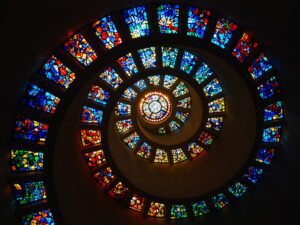Judaism
This section explains the various ways the Beatific Vision has been shown, depicted and described across the centuries within Judaism and the prophets.
Considering the more well-known visions in the Old Testament to Catholics, Hebrew Bible to Jews, I won’t spend too much time on them, but will simply reference the obvious image of import within the visions of Moses, Elijah and Ezekiel—Isaiah I already mentioned.
There are obviously differences on how they’re described since the vision is flowing through the particular prophet, but burning bush, the chariot wheel and the chariot wheel again in Ezekiel, but with more detail on the rotating element to the wheel within the wheel.
For those that don’t know, there’s an ancient and rich mysticism on the wheel itself called Merkabah or Merkava. I’ve seen it’s spelled differently so I’m not sure which is correct since I don’t speak Hebrew. What’s interesting is there’s a warning from the ancient sage that speaks about this form of prayer, Rabbi Akiva or Akiba, again same language issue, in that one can be struck with madness from the experience and or die. Now the madness is extremely possible considering the seeing of an eternity of thoughts in the mystical state and then the return to normal thinking since it is incredibly challenging to reorient the mind. Dying is maybe more metaphor than actual death since the actual experience does feel like death and rebirth.
In the same way that I spoke about St. Peter and the net, I simply wish to highlight a couple of mystical experiences in the Old Testament/Hebrew Bible that I didn’t know prior to having seen and understood the foundational symbol in the mystical state. A lot of this is in my upcoming book, “The Beatific Vision of God,” so I don’t want to use all of my material from that, so I’ll only highlight a bit.
I placed a flower in the image gallery, it’s an almond blossom. If you reread the beginning of Jeremiah Chapter 1: 11-13, God literally asks Jeremiah what he sees and Jeremiah responds a branch on the watching tree, which is considered an almond tree. A line later, he asks Jeremiah again what he sees, and Jeremiah answers a boiling cauldron. The notes in my Catholic Bible instantly jumps into allegorizing what Jeremiah sees, and if there’s a general theme with many of the visions in the Hebrew Bible and the New Testament, along with however it is other religions interpret their text, is that instantly jumping into allegorizing instead of reading the literal words on the page can lead to overthinking the writing, just as interpreting the literal components literally and without allegory or metaphor is obviously not thinking enough. There has to be a balance of the two. It’s a challenge of course to do so but in these three little lines, the mystical image of the chariot wheel in Elijah and the wheel within the wheel of Ezekiel are both symbolized instead by a flower and a boiling cauldron, again, since the images the mystic uses are based on their own personal knowledge and is the manner in which transmission becomes unique per person, community, city, country, nation, culture, religion, etc. But it is still the same image as long as we take the words of the scribe literally and know what to look for when they’re referring to the mystical experience and what is seen during it. . .
Scripture texts in this work are taken from the New American Bible, revised edition © 2010, 1991, 1986, 1970 Confraternity of Christian Doctrine, Washington, D.C. and are used by permission of the copyright owner. All Rights Reserved. No part of the New American Bible may be reproduced in any form without permission in writing from the copyright owner.


